
Adhesive, also known as glue, cement, mucilage, or paste, is any non-metallic substance applied to one or both surfaces of two separate items that binds them together and resists their separation.
A ski is a narrow strip of semi-rigid material worn underfoot to glide over snow. Substantially longer than wide and characteristically employed in pairs, skis are attached to ski boots with ski bindings, with either a free, lockable, or partially secured heel. For climbing slopes, ski skins can be attached at the base of the ski.
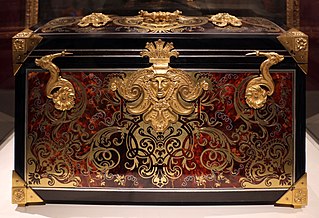
Marquetry is the art and craft of applying pieces of veneer to a structure to form decorative patterns, designs or pictures. The technique may be applied to case furniture or even seat furniture, to decorative small objects with smooth, veneerable surfaces or to freestanding pictorial panels appreciated in their own right.

Linoleum, sometimes shortened to lino, is a floor covering made from materials such as solidified linseed oil (linoxyn), pine resin, ground cork dust, sawdust, and mineral fillers such as calcium carbonate, most commonly on a burlap or canvas backing. Pigments are often added to the materials to create the desired colour finish.

Pietra dura or pietre dure, called parchin kari or parchinkari in the Indian Subcontinent, is a term for the inlay technique of using cut and fitted, highly polished colored stones to create images. It is considered a decorative art. The stonework, after the work is assembled loosely, is glued stone-by-stone to a substrate after having previously been "sliced and cut in different shape sections; and then assembled together so precisely that the contact between each section was practically invisible". Stability was achieved by grooving the undersides of the stones so that they interlocked, rather like a jigsaw puzzle, with everything held tautly in place by an encircling 'frame'. Many different colored stones, particularly marbles, were used, along with semiprecious, and even precious stones. It first appeared in Rome in the 16th century, reaching its full maturity in Florence. Pietra dura items are generally crafted on green, white or black marble base stones. Typically, the resulting panel is completely flat, but some examples where the image is in low relief were made, taking the work more into the area of hardstone carving.

A tea caddy is a box, jar, canister, or other receptacle used to store tea. When first introduced to Europe from Asia, tea was extremely expensive, and kept under lock and key. The containers used were often expensive and decorative, to fit in with the rest of a drawing-room or other reception room. Hot water was carried up from the kitchen, and the tea made by the mistress of the house, or under her supervision.

Intarsia is a form of wood inlaying that is similar to marquetry. The start of the practice dates from before the seventh century AD. The technique of intarsia inlays sections of wood within the solid wood matrix of floors and walls or of tabletops and other furniture; by contrast marquetry assembles a pattern out of veneers glued upon the carcass. The word intarsia may derive from the Latin word interserere.

Raden (螺鈿) is a Japanese term for one of the decorative techniques used in traditional crafts such as Japanese lacquerware and woodwork. It refers to a method of inserting a board-like material, which is a cut out part of the mother of pearl inside the shell, into the carved surface of lacquer or wood, or a craft made by using this method. The kanji for ra (螺) means shell and den (鈿) means inlaid. "Raden" is a term used only for the technique or work of inlaying thin layers of pearl shells. In Japan, the technique to inlay ivory or metal is simply called "象嵌, zougan or zōgan" which means inlay.

Wood finishing refers to the process of refining or protecting a wooden surface, especially in the production of furniture where typically it represents between 5 and 30% of manufacturing costs.

Animal glue is an adhesive that is created by prolonged boiling of animal connective tissue. In addition to being used as an adhesive it is used for coating and sizing, in decorative composition ornaments, and as a clarifying agent.
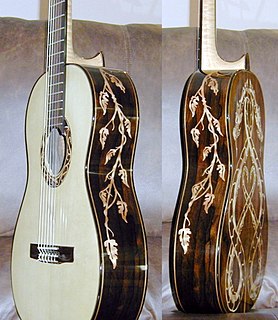
Inlay on guitars or similar fretted instruments are decorative materials set into the wooden surface of the instrument using standard inlay techniques. Although inlay can be done on any part of a guitar, it is most commonly found on the fretboard, headstock—typically the manufacturer's logo—and around the sound hole of acoustic guitars. Only the positional markers on the fretboard or side of neck and the rosette around the sound hole serve any function other than decoration. Nacre, plastic and wood are the materials most often used as inlay.
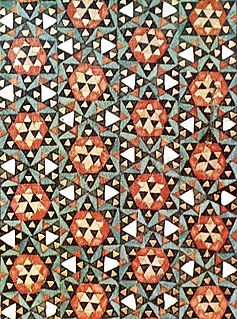
Khātam is an ancient Persian technique of inlaying. It is a version of marquetry where art forms are made by decorating the surface of wooden articles with delicate pieces of wood, bone and metal precisely-cut intricate geometric patterns. Khatam-kari (خاتمکاری) or khatam-bandi (خاتمبندی) refers to the art of crafting a khatam. Common materials used in the construction of inlaid articles are gold, silver, brass, aluminum and twisted wire.
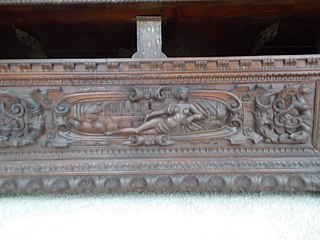
A hope chest, also called dowry chest, cedar chest, trousseau chest, or glory box is a piece of furniture traditionally used by unmarried young women to collect items, such as clothing and household linen, in anticipation of married life.

Hetepheres I was a Queen of Egypt during the Fourth Dynasty of Egypt.
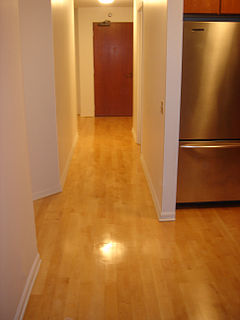
Wood flooring is any product manufactured from timber that is designed for use as flooring, either structural or aesthetic. Wood is a common choice as a flooring material and can come in various styles, colors, cuts, and species. Bamboo flooring is often considered a form of wood flooring, although it is made from a grass (bamboo) rather than a timber.

Bidriware is a metal handicraft from Bidar. It was developed in the 14th century C.E. during the rule of the Bahmani Sultans. The term "bidriware" originates from the township of Bidar, which is still the chief centre for the manufacture of the unique metalware. Due to its striking inlay artwork, bidriware is an important export handicraft of India and is prized as a symbol of wealth. The metal used is a blackened alloy of zinc and copper inlaid with thin sheets of pure silver. This native art form has obtained Geographical Indications (GI) registry.

Inlay covers a range of techniques in sculpture and the decorative arts for inserting pieces of contrasting, often coloured materials into depressions in a base object to form ornament or pictures that normally are flush with the matrix. A great range of materials have been used both for the base or matrix and for the inlays inserted into it. Inlay is commonly used in the production of decorative furniture, where pieces of coloured wood, precious metals or even diamonds are inserted into the surface of the carcass using various matrices including clearcoats and varnishes. Lutherie inlays are frequently used as decoration and marking on musical instruments, particularly the smaller strings.

A veneer hammer is a woodworking tool used in applying veneer.

Goryeo ware refers to all types of Korean pottery and porcelain produced during the Goryeo dynasty, from 918 to 1392, but most often refers to celadon (greenware).

The conservation and restoration of painting frames is the process through which picture frames are preserved. Frame conservation and restoration includes general cleaning of the frame, as well as in depth processes such as replacing damaged ornamentation, gilding, and toning.



















